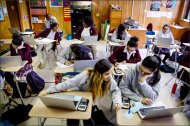 Jackie Cornejo, 16, left, and Elisa Martinez, 16, work on a problem in a math class at the Young Women's College Preparatory Academy in Houston. The school is one of the first in the Houston district to give laptops to students for use at school and at home.
Jackie Cornejo, 16, left, and Elisa Martinez, 16, work on a problem in a math class at the Young Women's College Preparatory Academy in Houston. The school is one of the first in the Houston district to give laptops to students for use at school and at home.
—Michael Paulsen/Houston Chronicle
Texas district is hoping to avoid others' missteps
Undeterred by high-profile problems experienced by other large school systems attempting to put digital devices in the hands of their students, the Houston Independent School District began distributing more than 18, 000 laptop computers to high schools last month.
Officials from the 210, 000-student district point to several elements of their plan as reasons for optimism: Unlike the troubled iPad initiative in Los Angeles, for example, Houston will give students laptops instead of digital tablets; rely on "Web 2.0 tools" rather than a pre-loaded digital curriculum; and offer extensive training for students and staff members before the devices are deployed.
Instead of paying for the leased devices with bonds, the Houston district will also fund its 1-to-1 program, dubbed PowerUp, with repurposed savings, operating dollars, and grant funds.
The Houston initiative is the largest, but not the only, student computing effort in an urban district to take a significant step forward in recent weeks, a sign that districts may be overcoming the skittishness that emerged in the wake of well-publicized missteps in Los Angeles, Guilford County, N.C., and Fort Bend, Texas.
"I find [Houston ISD's] planning to be admirable, " said Leslie Wilson, the chief executive officer of the One-to-One Institute, a nonprofit based in Mason, Mich., that provides assistance to districts implementing student-computing initiatives. "I think a lot of these hiccups that we've seen have really helped refocus districts on teaching and learning, rather than on hardware and publishers who are trying to sell you a bill of goods."
For almost a decade, K-12 schools have been embracing 1-to-1 computing as a means for increasing students' access to technology and preparing them for college and the workforce. When examined from a wide view, said Ms. Wilson of the One-to-One Institute, that trend continues unabated.
Series of Skirmishes
But last fall, the 651, 000-student Los Angeles Unified School District became the symbol for 1-to-1 initiatives gone awry. Almost from its inception, the effort was plagued by security issues, confusion about who is responsible for the tens of thousands of iPads being distributed, criticisms around cost and the use of bond financing, and concerns about the readiness and price of the pre-loaded curriculum purchased along with the devices.
Following a series of skirmishes, with the district's board and teachers' union, Superintendent John Deasy was forced to slow the pace of the rollout. In January, the district's board voted to continue with the initiative's second phase, in which iPads will be distributed to 38 more campuses.









